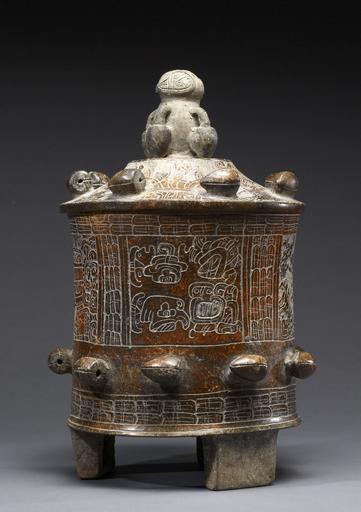MAKE A MEME
View Large Image

| View Original: | Mayan_-_Lidded_Vessel_-_Walters_20092039_-_Side_C.jpg (1269x1800) | |||
| Download: | Original | Medium | Small | Thumb |
| Courtesy of: | commons.wikimedia.org | More Like This | ||
| Keywords: Mayan - Lidded Vessel - Walters 20092039 - Side C.jpg The Classic Maya political landscape was divided into more than two dozen polities similar to city-states composed of a primary site plus aligned towns and villages Each was headed by a royal lineage supported by noble families and the polities often competed against each other for political and economic supremacy Feasts sponsored by the ruling elite provided a crucial platform for securing relations among aligned parties and negotiating new alliances Feasts were integral to elaborate affairs of state from rulers' accession rites to royal weddings to war victory celebrations and special religious observances The consumption of large amounts of sumptuous foods including drinks made from highly valued cacao chocolate was a focal point The banquets prompted the production of finely made food-service wares in the form of pictorial pottery their decorative imagery often featuring themes lauding the earthly or supernatural prowess of the host These ornate vessels also functioned as gifts their acceptance signaling the guests' alliance or at least an association with the host The vase's hieroglyphic text confirms its function as a drinking vessel-kakaw yuk'ib or the cacao drinking cup of The text goes on to name the cup's patron/owner at B2 and his father at d1-d2 Chakjal Mukuuy Reddening Dove Neither of these individuals is known from other Early Classic hieroglyphic texts and thus we do not know their political or familial identities Yet the artistic quality of the vessel and its detailed nominal phrase indicate their being members of the nobility if not a royal dynasty of the fourth-fifth centuries The two hieroglyphic texts are separated by pictorial panels featuring the maize god as an embodied cacao tree His bejeweled headdress is topped by a sprouting cacao tree like those adorning the vase's lid Modeled cacao pods embellish the vessel and the lid's knob is a cacao tree with a bird now broken The avian may be the false sun of the previous creation and avatar of the deity Itz'amnaj God D Uniting text and image panels are overlapping bands of cacao leaves The preponderance of cacao imagery supports the interpretation of the text's unusual introductory glyphs a1-b1 as sprouting cacao based on the first sign's resemblance to the vase's sprouting trees see the Maize god's headdress and its sub-fixed sign -la a well-known adjectival element in Maya hieroglyphic writing AD 250-550 Early Classic earthenware slip with incising cm 34 77 22 86 accession number 2009 20 39 80194 Stendahl Galleries Los Angeles date and mode of acquisition unknown John G Bourne 1970s by purchase Walters Art Museum Gift of John Bourne 2009 place of origin Guatemala Walters Art Museum license Maya art in the Walters Art Museum Maya tripod vessels Media contributed by the Walters Art Museum needs category review Maize god | ||||